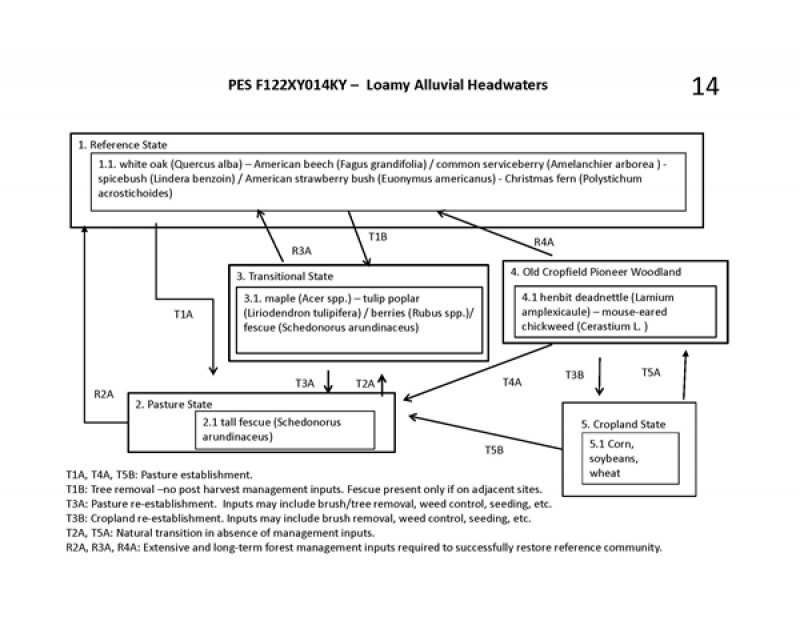
Natural Resources
Conservation Service
Ecological site F122XY014KY
Deep Well Drained Cherty Uplands
Last updated: 5/14/2025
Accessed: 12/20/2025
General information
Provisional. A provisional ecological site description has undergone quality control and quality assurance review. It contains a working state and transition model and enough information to identify the ecological site.
MLRA notes
Major Land Resource Area (MLRA): 122X–Highland Rim and Pennyroyal
MLRA 122 is in Tennessee (47 percent), Kentucky (43 percent), Indiana (7 percent), and Alabama (3 percent). It makes up about 21,530 square miles (55,790 square kilometers).
SOILS:
Many of the soils in this MLRA are Udalfs. The moderately deep to very deep, well drained, clayey soils formed in limestone residuum. They are dominantly in rolling to steep areas of the “Outer Basin” (Mimosa, Braxton, Gladdice, and Hampshire series) and the undulating to hilly areas of the “Inner Basin” (Talbott and Bradyville series). The most agriculturally productive soils are the very deep, well drained, clayey or loamy soils that formed in alluvium and/or loess over alluvium or limestone residuum in nearly level to undulating areas (Armour, Cumberland, Harpeth, Lomond, and Maury series). The less extensive soils generally are moderately well drained to somewhat poorly drained and formed in loamy or clayey alluvium and/or residuum (Byler, Capshaw, Colbert, and Tupelo series). This MLRA has a significant acreage of Mollisols. Shallow or moderately deep, well drained, clayey Udolls (Ashwood and Barfield series) formed in limestone residuum dominantly in rolling to steep areas. Very shallow, well drained, clayey Rendolls (Gladeville series) formed in limestone residuum dominantly in undulating to rolling areas of the “Inner Basin.” Very deep, well drained or moderately well drained Udolls (Arrington, Egam, Lynnville, and Staser series) and somewhat poorly drained or poorly drained Aquolls (Agee, Godwin, and Lanton series) formed in loamy or clayey alluvium derived from limestone on flood plains. Most of the remaining soils on flood plains are moderately well drained or well drained Udepts (Lindell and Ocana series). Udults are of small extent in this area. Most are very deep, well drained, and loamy and formed in gravelly colluvium or colluvium and the underlying residuum on steep hillsides (Dellrose soils). Rock outcrops are common on uplands.
BIOLOGICAL RESOURCES:
This area supports mixed oak forest vegetation. White oak, black oak, northern red oak, and some scarlet oak are the dominant tree species. Shagbark hickory, bitternut hickory, pignut hickory, and mockernut hickory also occur. Oak, blackgum, flowering dogwood, sassafras, Virginia pine, pitch pine, and shortleaf pine grow mostly on ridgetops.
(Excerpt from United States Department of Agriculture, Natural Resources Conservation Service. 2006. Land Resource Regions and Major Land Resource Areas of the United States, the Caribbean, and the Pacific Basin. U.S. Department of Agriculture Handbook 296.)
Classification relationships
Scientific Name: Southern Interior Low Plateau Dry-Mesic Oak Forest, Unique Identifier: CES202.898
Possible Association:
Quercus falcata - Quercus alba - Carya alba / Oxydendrum arboreum / Vaccinium stamineum Forest
Translated Name: Southern Red Oak - White Oak - Mockernut Hickory / Sourwood / Deerberry Forest
Common Name: Interior Southern Red Oak - White Oak Forest
Unique Identifier: CEGL007244
Classification Approach: International Vegetation Classification (IVC)
Ecological site concept
Only two tree species can be selected for entry into the database as dominants; however, multiple tree species may be dominant on these sites depending on aspect, soil depth, seed sources, management, and disturbance history.
State 1. Forestland.
Phase 1.1: Plant species dominants:
White oak – southern red oak/ blueberry – smilax / Virginia snakeroot – licorice bedstraw.
(Quercus alba - Quercus falcata / Vaccinium spp. - Smilax spp. / Aristolochia serpentaria –Galium circaezans)
State: 2. Pasture
Phase 2.1: Managed Pasture. Plant species dominants: Schedonorus arundinaceus (tall fescue)
Pasture plant species are dependent on seeding, weed control, concurrent land uses, on-going levels of disturbance, and landowner goals. Individual site and soil characteristics, along with management activities, will influence production levels.
State: 3 – Transitional (Abandoned Field)
Phases 3.1: Plant species dominants: Juniperus virginiana/ Rubus spp.- Rosa multiflora/ Vernonia gigantea -Schedonorus arundinaceus
Eastern red cedar /blackberry – multiflora rose/ ironweed- tall fescue
Tree species regeneration on these sites will depend on disturbance, soil characteristics, adjacent plant communities and seed sources, post-disturbance management inputs, presence or absence of continued site disturbances(grazing), slope, and aspect.
State 4: Phase 4.1. Abandoned Croplands
Plant species dominant:
henbit deadnettle (Lamium amplexicaule) – mouse-eared chickweed (Cerastium L.)
Abandonment of cropland would result in many weed species taking over the site. Initially, annual weeds would be predominate followed by grasses, shrubs and finally, pioneers trees.
State 5: Phase 5.1. Cropland
Dependent upon seeding and management. Most common crops are corn and soybeans.
It would require years of management, plantings, and weed control to establish successional communities that could transition to a reference community
Associated sites
| F122XY016KY |
Riverbank Loamy Alluvium Riverbank Loamy Alluvium |
|---|
Table 1. Dominant plant species
| Tree |
(1) Quercus alba |
|---|---|
| Shrub |
(1) Vaccinium |
| Herbaceous |
(1) Aristolochia serpentaria |
Click on box and path labels to scroll to the respective text.
